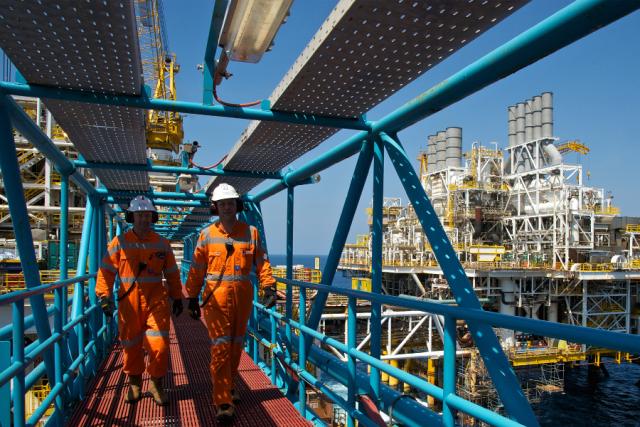
Workers walk on a rig in the Bayu Undan Field offshore Australia. Gas from the field feeds the ConocoPhillips-led Darwin LNG development. (Source: ConocoPhillips)
Santos says it is primed to take advantage of brownfield expansion and extension opportunities offshore northern Australia and is progressing activities in the area accordingly.
Santos’ Western Australia and Northern Territory general manager Joe Ariyaratnam, who spoke on the company’s ability to meet Asia’s insatiable energy demand via brownfield development at the South East Asia Australia Offshore & Onshore Conference (SEAAOC) conference in Darwin, told delegates expansion projects would be most cost effective when it came to meeting future LNG demand.
“The projects that will capture that unmet LNG demand will be those projects that can deliver gas most cost competitively,” he said. “Brownfield expansions are competitive with LNG supply from the rest of the world. A greenfield plant is probably going to cost you about US $1,800 a tonne; brownfield [is] probably closer to about $1,000/t.”
When it came to brownfield opportunities, Ariyaratnam said Santos was well positioned in northern Australia, adding that the company was continuing to chase multitrillion cubic feet opportunities in the offshore Browse and Bonaparte basins to build on its discovered resource base.
The ConocoPhillips-led Darwin LNG (DLNG) development has been the jewel in Darwin’s oil and gas crown for some time, but with the Bayu-Undan fed plant set to reach production plateau in 2020, the project has been on the hunt for more gas to continue operations into the next decade.
Santos is a minority stakeholder in DLNG, alongside Eni, Inpex and Tokyo Electric Power.
Ariyaratnam said while DLNG had a space for an additional train, with approvals in place for up 10Mtpa, it was critical not to discount the importance of backfill which could also be a pathway to commercialize Santos’ resources off Australia’s north coast.
“There is some time until Bayu-Undan comes off plateau so there is time to get this right,” he remarked.
Ariyaratnam said the Crown and Lasseter gas discoveries in the Browse Basin “were absolute contenders for DLNG backfill or an expansion,” due in part to collaboration opportunities presented by infrastructure in the area.
Meanwhile, the ConocoPhillips-operated Caldita-Barossa fields in the Bonaparte Basin are both contenders for DLNG feedstock. Santos has a 25 percent interest in the fields.
The partners wrapped up a successful three-well appraisal drilling campaign at the fields earlier this year, which confirmed a better quality and larger resource than originally anticipated.
Ariyaratnam said drilling of the Barossa 3 well “blew us away” after it intersected 104 m of net gas play.
“This well has really delivered a step-change in resource position and the development options that are available for this field,” he said.
Off that success, the JV has been able to hit the ground running with further engineering definition being undertaken to bring the project forward.
“The JV is aiming to be moving into a pre FEED stage in the first half of next year,” he said. “It’s a strong contender for DLNG backfill.”
By 2016, more than a third of Santos’ production will be sold as LNG into Asian markets and Ariyaratnam tipped brownfield expansions would play a key role in maintaining the company’s market share moving forward.
“I certainly believe that our northern Australia assets, through brownfield expansion, will be the key part of this next phase of growth,” he said.
Lauren Barrett can be reached at lbarrett@hartenergy.com.
Recommended Reading
US Raises Crude Production Growth Forecast for 2024
2024-03-12 - U.S. crude oil production will rise by 260,000 bbl/d to 13.19 MMbbl/d this year, the EIA said in its Short-Term Energy Outlook.
E&P Highlights: March 11, 2024
2024-03-11 - Here’s a roundup of the latest E&P headlines, including a new bid round offshore Bangladesh and new contract awards.
Galp Seeks to Sell Stake in Namibia Oilfield After Discovery, Sources Say
2024-04-22 - Portuguese oil company Galp Energia has launched the sale of half of its stake in an exploration block offshore Namibia.
Exxon Versus Chevron: The Fight for Hess’ 30% Guyana Interest
2024-03-04 - Chevron's plan to buy Hess Corp. and assume a 30% foothold in Guyana has been complicated by Exxon Mobil and CNOOC's claims that they have the right of first refusal for the interest.
Petrobras to Step Up Exploration with $7.5B in Capex, CEO Says
2024-03-26 - Petrobras CEO Jean Paul Prates said the company is considering exploration opportunities from the Equatorial margin of South America to West Africa.



